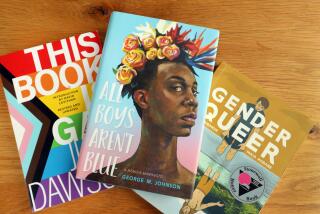HOW TO INTRODUCE YOUR KIDS TO QUALITY CHILDREN’S LITERATURE : Reading by 9
- Share via
Editor’s Note: As part of the Times’ Reading by 9 initiative, Book Review is publishing a monthly series on how parents can introduce kids to the best children’s literature.
*
Ask children how they choose a book, and they will tell you, not surprisingly, by the cover. Children are attracted to flashy, colorful objects, and books are no exception. Parents of children who read picture books know this first hand; attractive art can lure a child to a well-conceived, well-written picture book.
For older children, though, this formula no longer applies; cover art often has little to do with what is inside. But these readers still tend to pick books based on their cover artwork, and so publishers of young adult books often use graphically exciting images to advertise their wares. The popular horror series books, for example, employ cover art with garish colors, shiny foil lettering and sometimes even a creepy 3-D hologram. No wonder these series-du-jour jump off the shelves. Publishers of classic tales, too, are employing these techniques; new editions of the older classics are usually paperbacks with modern cover illustrations depicting, say, a hipper “Alice in Wonderland” with an updated outfit and trendier hair, compared with Sir John Tenniel’s solemn Victorian Alice. Similarly, that beautifully bound hardcover edition of “Little Women” is wonderful to have on the shelf, but a softcover version with the four March sisters in colorful gowns, gaily singing round the piano (never mind that the book reveals the girls’ gowns are faded and much-mended) is probably more likely to be tossed in a backpack. Keep this While this may not be fair to the content of the books, it is not unusual to expect your child to be attracted to the most provocative, or the most identifiable, dust jacket. You can also play it to your advantage when you buy gift books and don’t know the child’s tastes or the book’s content.
Parents can also play a important role weaning older readers away from choosing books by their cover. Encouraging children to look at the inside flap or the back cover for information on the story and the author of a book is a start. But be aware that most book blurbs and quotes are written and designed by publishers as advertising and should be read with a discerning eye. One easy way to read through the hype is to see who is being quoted; if it is an author you or your child has enjoyed reading in the past, then chances are you will enjoy his or her recommendation.
Beyond the book’s cover and the blurb, encourage your child to read the first chapter; reassure them that it is all right, if they chose, not to complete a book. Nothing takes the fun out of reading more than the requirement to complete a book from cover to cover, and the first-chapter test is a wonderful way for parents to ease their children into a new book. If they read the first chapter and find it intriguing, they’re likely to finish that book.
Children should also look at a book’s language in choosing what to read. Language that kids can understand is language they will follow for the entire book. But know that there are also limitations to this: Children might neglect certain classics in favor of something a little more modern, and this would be a shame. But this is where parents can help. Some children who start “The Yearling” by Marjorie Rawlings, for example, are initially put off by the heavy use of dialect. Adults can give a nudge, reading the first chapter aloud to acquaint their child with the language, to get him or her past that first chapter.
Parents should also not be afraid of exercising their critical judgments. Children will readily read “status books,” the books everyone else in school is reading, and while this should not to be discouraged, their choices can be broadened. If your child for instance enjoys reading the Harry Potter series of books, talk to your librarian for a comparable title and you might find that “The Once and Future King” has a comparable appeal.
Though the goal is to get your child reading, it is equally important to familiarize them with the thousands of titles available.
More to Read
Sign up for our Book Club newsletter
Get the latest news, events and more from the Los Angeles Times Book Club, and help us get L.A. reading and talking.
You may occasionally receive promotional content from the Los Angeles Times.










